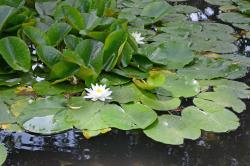- Taxon
- Weed
- Gallery
Perennial, aquatic herb with creeping, horizontal, sparsely branching rhizomes. Stolons absent. Brood-bodies absent. Roots adventitious. Leaves weakly dimorphic (submerged leaves broadly deltoid); stipules free; petiole terete, attachment narrowly peltate; floating lamina (60–)120–250 × 60–100(–220) mm, elliptic to suborbicular, deeply cordate (lobe margins usually overlapping), coriaceous, glossy, glabrous, upper surface dark-green; margin entire. Flowers (70–)100–140 mm in diameter, solitary, held on or above the water surface on peduncles 3.5–9 mm in diameter; slightly sweet-scented (on the first day) or odourless; outer tepals 4, 30–80 mm long, lanceolate to oblong or ovate, apex acute to subacute, inner surface white, outer surface green or reddish, obscurely veined. Inner tepals numerous, 40–90 mm long, outermost as long as outer tepals, lanceolate, ovate or oblong, usually white both sides or cream; rarely red or pink. Stamens numerous, 11–12 mm long, filaments and anthers yellow, appendages absent. Ovary syncarpic, globose with short triangular-ovate stylar processes. Fruit globose or semi-globose. Seeds 2–3 × 2 mm, ellipsoid or ovoid, smooth, dark olive green, glabrous.
Distinguished by white flowers (or sometimes red or flushed pink) compared with the blue and yellow flowers of Nymphaea capensis and N. mexicana, respectively. Nymphaea alba also has a branching, horizontal rhizome and glabrous seeds, whereas N. capensis and N. mexicana have a non-branching, erect, caudex-like rhizome and the seeds are hairy.
North Island: Northland – Waitangi River, Waitakere River, Te Henga wetland (Bethells wetland); Auckland – Western Springs; Southern North Island – Hawke's Bay (Kakaponui Stream, Manhungaharuru Range), Manawatū–Wanganui (Lakes Waikato, Wiritoa, Pauri).
South Island: Western Nelson – Lake Rotoiti; Westland – Lake Kaniere, drain at Sponge Swamp, lower Kokatahi Valley, Lake Māhinapua, Pāringa River, roadside pond Waiatoto; Canterbury – near Motukārara; Southland – Stewart Island (Martins Creek, Freshwater River).
Occurs naturally in Europe, North Africa and Central Asia.
Water lilies have been planted in many locations (Garnock-Jones 1988).
Locations were recorded but not vouchered in herbaria. North Auckland: Lake Kereta, Waiti Stream, Mokoroa Stream.
Auckland: Lakes Ōkaihau, Paekawau, Pupuke. Waikato: Rotoroa, Otamatearoa, Mangakaware, Hakano, Waahi, Kimihia. Bay of Plenty: Lake Rotoiti. Manawatū-Wanganui: Lakes Westmere, Dudding, Virginia, Centennial Lagoon (Palmerston North), Ōhinetonga Lagoon. Wellington: Lake Waitawa (NIWA unpublished records).
Growing in a deep mud/silt substrate in stagnant waters of sheltered bays of lakes, ponds, drains and slow-flowing streams and rivers.
Recorded to depths up to about 3 m depending on water clarity and capable of tolerating a small degree of brackish water (Heslop-Harrison 1955).
AK 35855, CHR 69651, R. Mason, R. Cooper & N.T. Moar, 3 Dec. 1949, Waitangi River, Bay of Islands, (cited in Mason et al. 1950).
Flowering: Nov.–Feb.
2n = 48, 64, 96, 112 (Heslop-Harrison 1955).
Many ‘hardy water lily’ cultivars fit into Nymphaea alba but are almost certainly of hybrid origin involving N. alba, N. alba var. rubra Lönnr. (Swedish red water lily), N. mexicana (yellow water lily) and other species of N. subgenus Nymphaea, particularly, N. odorata and N. tetragona, and their stabilised and fertile hybrid, N. candida.












